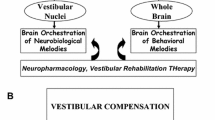Abstract
This contribution will give an overview of our studies on compensatory CNS phenomena occurring after labyrinthine lesions in guinea pigs (Dal Ri and Schaefer 1956, 1957; Schaefer and Wehner 1966; Schaefer and Meyer 1973, 1974; Schaefer et al. 1978, 1979; Meyer et al. 1981). It attempts to combine various aspects of seemingly heterogeneous studies which were performed under different experimental conditions, such as cortical and cerebellar ablations, spinal transection, and under the influence of several types of drugs. From these investigations a somewhat more advanced picture of the compensatory phenomena following unilateral as well as bilateral vestibular lesions has evolved. Furthermore, information has been gained with respect to more fundamental aspects of how parts of the CNS work and interact, e.g., insights obtained into mechanisms of multisensory convergence relevant in the context of vestibular compensation may eventually lead to a new definition of cerebellar functions.
Access this chapter
Tax calculation will be finalised at checkout
Purchases are for personal use only
Preview
Unable to display preview. Download preview PDF.
Similar content being viewed by others
References
Azzena GB (1969) Role of the spinal cord in compensating the effects of hemilabyrinthectomy. Arch Ital Biol 107: 43–53
Azzena GB, Mameli O, Tolu E (1979) Cerebellar contribution in compensating the vestibular function. In: Granit R, Pompeiano O (eds) Reflex control of posture and movement. Progress in brain research, vol 50. Elsevier, Amsterdam New York Oxford, pp 599–606
Bechterew W von (1883) Ergebnisse der Durchschneidung des N. acusticus, nebst Erörterung der Bedeutung der semicirculären Kanäle für das Gleichgewicht. Arch Ges Phys 30: 312–347
Bienhold H, Flohr H (1980) Role of cholinergic synapsis in vestibular compensation. Brain Res in press
Dal Ri H, Schaefer K-P (1956) Pharmakologische Untersuchungen am artifiziellen Dauernystagmus des Meerschweinchens. Naunyn-Schmiedebergs Arch Exp Pathol Pharmakol 234: 79–90
Dal Ri H, Schaefer K-P (1957) Beeinflussing des Nystagmus durch Stell-und Haltereflexe am nichtfixierten Meerschweinchen. Pflügers Arch 265: 125–137
Dieringer N, Precht W (1979) Synaptic mechanisms involved in compensation of vestibular function following hemilabyrinthectomy. In: Granit R, Pompeiano O (eds) Reflex control of posture and movement. Progress in brain research, vol 50. Elsevier, Amsterdam New York Oxford, pp 607–615
Giretti ML (1971) Spinal compensation of the cerebral release phenomena. Exp Neurol 30: 459–466
Kolb E (1955) Untersuchungen über zentrale Kompensation und Kompensationsbewegungen einseitig entstateter Frösche. Z Vergl Physiol 37: 136–160
Llinás R, Walton K (1977) Significance of the olivo-cerebellar system in compensation of ocular position following unilateral labyrinthectomy. In: Baker R, Berthoz A (eds) Control of gaze in brain stem neurons.. Elsevier, Amsterdam New York Oxford, pp 399–408
Llinâs R, Walton K, Hillman DE, Sotelo C (1975) Inferior olive: its role in motor learning. Science 190: 1230–1231
Magnus R (1924) Körperstellung. Springer, Berlin
McCabe BF, Ryu JH (1969) Experiments on vestibular compensation. Laryngoscope 79: 1728–1736
Menzio P (1949) Rapporti fra la corteccia cerebral ed i fenomeni di emislabirintazione. Arch Frisiol 49: 97–104
Meyer DL, Maurer K, Schaefer K-P (1981) Pharmacological influence on vestibular compensation. Submitted
Precht W, Shimazu H, Markham CH (1966) A mechanism of central compensation of vestibular function following hemilabyrinthectomy. J Neurophysiol 29: 996–1010
Russel LSR (1894/95) An experimental investigation of eye-movements. J Physiol (London) 17: 1–26
Sanchez-Robles S, Anderson JH (1978) Compensation of vestibular deficits in the cat. Brain Res 147: 183–197
Schaefer K-P, Meyer DL (1973) Compensatory mechanisms following labyrinthine lesions in the guinea pig. A simple model of learning. In: Zippel HP (ed) Memory and transfer of information. Plenum Press, New York London, pp 203–332
Schaefer K-P, Meyer DL (1974) Compensation of vestibular lesions. In: Kornhuber H (ed) Handbook of sensory physiology, vol VIII. Vestibular system, part 2. Psychophysics. Applied aspects and general interpretation. Springer, Berlin Heidelberg New York, pp 463–490
Schaefer K-P, Wehner H (1966) Zur pharmakologischen Beeinflussung zentralnervöser Kompensationsvorgänge nach einseitiger Labyrinthausschaltung durch Krampfgifte und andere erregende Substanzen. Naunyn-Schmiedebergs Arch Pharmakol Exp Pathol 254: 1–17
Schaefer K-P, Wilhelms G, Meyer DL (1978) Der Einfluß von Alkohol auf die zentralnervösen Ausgleichsvorgänge nach Labyrinthausschaltung. Z Rechtsmed 81: 249–260
Schaefer K-P, Meyer DL, Wilhelms G (1979) Somatosensory and cerebellar influences on compensation of labyrinthine lesions. In: Granit R, Pompeiano O (eds) Reflex control of posture and movement. Progress in brain research, vol 50. Elsevier, Amsterdam New York Oxford, pp 591–598
Simonelli G (1923) Un metodo di distruzione chemica del labirinto. Arch Fisiol 21: 231–233
Spiegel EA, Demetriades TD (1925) Die zentrale Kompensation des Labyrinthverlustes. Pflügers Arch 210: 215–222
Author information
Authors and Affiliations
Editor information
Editors and Affiliations
Rights and permissions
Copyright information
© 1981 Springer-Verlag Berlin Heidelberg
About this paper
Cite this paper
Schaefer, KP., Meyer, D.L. (1981). Aspects of Vestibular Compensation in Guinea Pigs. In: Flohr, H., Precht, W. (eds) Lesion-Induced Neuronal Plasticity in Sensorimotor Systems. Proceedings in Life Sciences. Springer, Berlin, Heidelberg. https://doi.org/10.1007/978-3-642-68074-8_16
Download citation
DOI: https://doi.org/10.1007/978-3-642-68074-8_16
Publisher Name: Springer, Berlin, Heidelberg
Print ISBN: 978-3-642-68076-2
Online ISBN: 978-3-642-68074-8
eBook Packages: Springer Book Archive




